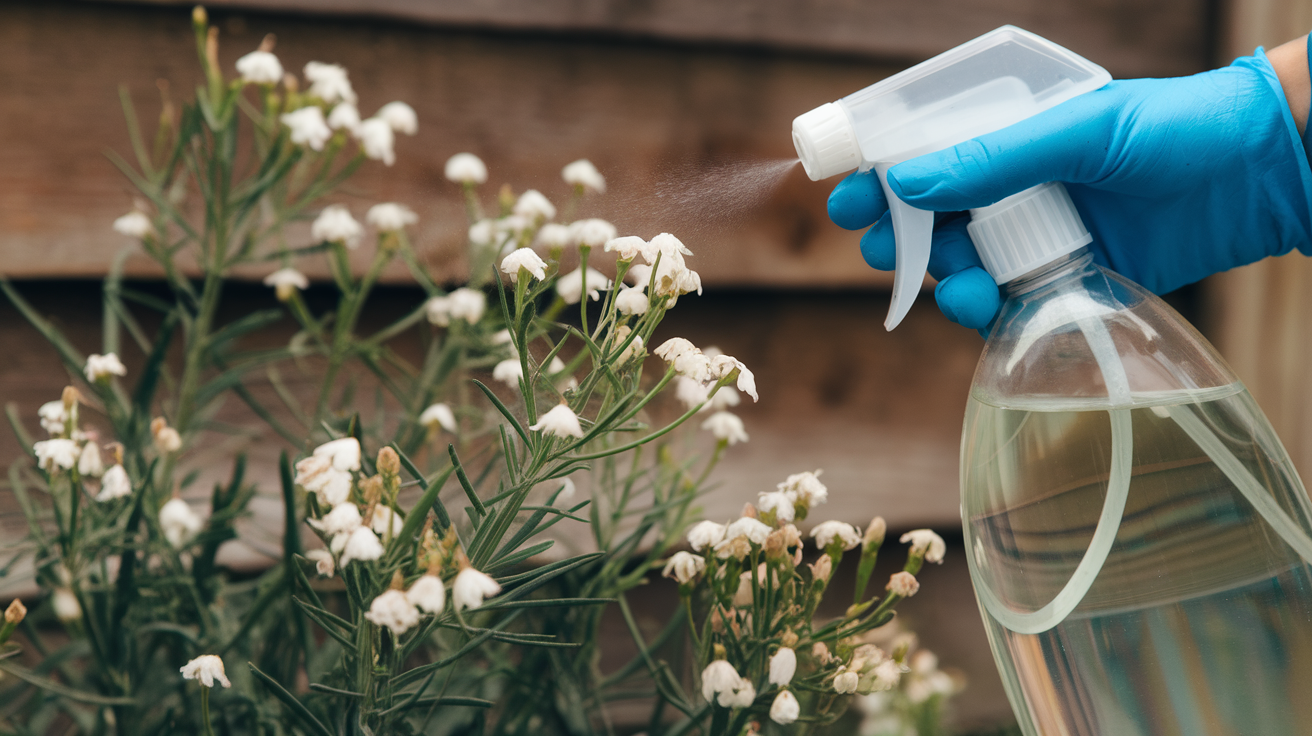Garden bugs destroyed basil plants year after year, leaving gardeners frustrated and ready to give up on growing herbs.
Everything is tried, from store-bought sprays to copper barriers, and even hand-picking bugs at dawn. Nothing worked until this simple kitchen ingredient combination changed everything.
What if four everyday household items could save gardens from pest damage?
This natural spray repels bugs without harmful chemicals, costs pennies to produce, and works more effectively than expensive commercial products.
Here’s the exact recipe that changed bug-eaten gardens into thriving spaces. Keep reading to learn how to make this powerful natural pest deterrent that protects plants for weeks with just one application.
How Does Garlic Spray Work For Plants?
Garlic spray works because bugs hate the smell. When you spray it on plants, insects smell the pungent garlic and stay away.
- The Strong Smell Keeps Bugs Away: Garlic has sulfur compounds that create a powerful smell. Bugs have sensitive noses and find this smell too strong. They avoid plants that smell like garlic because it signals danger to them.
- Garlic Tastes Bad to Insects: If bugs try to eat leaves treated with garlic spray, they experience a burning sensation in their mouth. This makes them stop eating and look for other plants. The sour taste teaches them to avoid your garden.
- Fresh Garlic Works Best: Fresh garlic cloves have more pest-fighting power than garlic powder. When you chop fresh garlic and let it sit overnight, it releases more oils. These oils adhere to plant leaves and continue to work for days.
- What Bugs Stay Away: Garlic spray is effective against many common garden pests, including aphids and cucumber beetles. It works best on soft bugs that use smell to find food. Hard-shelled bugs might not be as bothered by the smell.
The spray doesn’t kill good bugs like bees. It just drives nasty bugs away to find somewhere else to eat.
Step-by-Step Guide to Make Garlic Spray For Plants
Create a powerful natural garden bug repellent by blending mint and garlic, boiling with cayenne, steeping overnight, straining, and mixing with soap, then spraying onto plants for adequate, eco-friendly pest protection.
Tools Required
| Tool | Function |
|---|---|
| Food processor or blender | Chop the mint and garlic to release their essential oils, which repel bugs. |
| Large pot | Heats the mixture to activate pest-fighting compounds in the ingredients. |
| Strainer | Removes plant debris to create a smooth spray that won’t clog spray nozzles. |
| Large container | Collects the strained liquid and allows easy mixing with soap. |
| Spray bottle or garden sprayer | Apply even coverage of repellent to all plant surfaces. |
Materials Required
| Material | Purpose |
|---|---|
| 3 cups fresh mint leaves | Primary pest deterrent containing natural oils bugs hate |
| Garlic cloves | Provides sulfur compounds that strongly repel insects |
| 2 teaspoons cayenne pepper | Adds a burning sensation that deters bugs from eating plants |
| Water | Dilutes concentrated ingredients for safe plant application |
| Biodegradable soap | Helps spray stick to leaves and breaks down safely in soil |
Step 1: Prepare the Mint Base

Put 3 cups of fresh mint leaves into a food processor. Don’t worry about removing stems; they add extra oils that bugs hate. Process until roughly chopped but not completely pulverized.
The mint releases natural oils that insects find unpleasant. You want pieces small enough to release oils but not so fine that they turn into mush. This creates the foundation for your pest-repelling spray.
Hidden benefit: Mint naturally deters ants, mice, and moths too, so this spray works for multiple garden problems.
Step 2: Add and Chop Garlic

Add several garlic cloves to the chopped mint. Pulse the processor a few times until the garlic is broken into small pieces. You want chunks, not paste. Garlic contains sulfur compounds that bugs dislike.
Don’t over-process because you need the garlic pieces to release their oils slowly during the steeping process. Fresh garlic is much more potent than dried or powdered versions for this recipe.
Seasonal timing: Make this spray in late spring when garlic is freshest and most pungent for maximum bug-fighting power.
Step 3: Boil the Mixture

Transfer everything to a large pot and add enough water to cover the contents. Add 2 teaspoons of cayenne pepper and stir until well combined. Bring to a rolling boil, then immediately remove from the heat.
The heat activates the oils in the mint and garlic, while the cayenne adds an extra layer of protection. Don’t boil too long, or you’ll lose the potent oils that make this spray work effectively against garden pests. Let the mixture sit covered overnight.
Safety note: Open windows while boiling the cayenne can make the air spicy and cause coughing if the kitchen isn’t well-ventilated.
Step 4: Strain and Add Soap

Pour the mixture through a strainer into a large container to remove all plant matter. Add 2-3 squirts of biodegradable soap and mix gently. The soap helps the spray adhere to plant leaves, preventing it from rolling off like water. Use biodegradable soap to avoid harming beneficial insects and soil microbes.
The strained liquid should be a greenish-brown color and have a strong odor. This concentrated solution is now ready for application.
Storage secret: Keep unused spray in the refrigerator for up to one week it stays potent longer when kept cool.
Step 5: Apply to Plants

Pour the mixture into a spray bottle and coat all plant surfaces, especially under leaves, where bugs tend to hide. Spray early morning or evening to avoid leaf burn from the sun hitting wet leaves. Ensure complete coverage, as bugs will find any untreated spots.
The spray doesn’t kill insects but repels them effectively. Reapply after rain or heavy watering, as natural ingredients can wash away, unlike chemical pesticides.
Application trick: Test spray on one leaf first and wait 24 hours to make sure your specific plants don’t have sensitivity reactions.
Video Tutorial
Special thanks to AnOregonCottage for providing valuable insights in their video, which I referenced while creating this guide.
Extra Ingredients You Can Add to Boost Your Bug Spray
Enhance your homemade pest spray by adding these natural ingredients, each offering extra protection against bugs and plant diseases.
| Ingredient | Purpose | Precautions |
|---|---|---|
| Neem Oil | Disrupts pest hormones; acts as a natural insecticide | Use lightly; may burn leaves in full sun |
| Rosemary Essential Oil | Repels flying insects like whiteflies and mosquitoes | Dilute well; strong oils can irritate plants |
| Apple Cider Vinegar | Mild insect deterrent and antifungal | Too much can harm delicate plants; test first |
| Onion | Enhances garlic’s repellent power against aphids and beetles | Blend with garlic; it has a strong smell |
| Lemon Peel | Contains limonene, a natural insect repellent | Avoid spraying in direct sunlight to prevent leaf burn |
| Baking Soda | Helps prevent fungal infections like powdery mildew | Not insecticidal, but supports healthy foliage when used moderately |
Always test new additions on a small area first to ensure your plants tolerate them well. Natural doesn’t always mean risk-free!
When to Use Garlic-Mint Spray?
Learn the optimal times and practical tips for applying garlic mint spray to protect your garden from pests throughout the entire growing season.

Wrapping It Up
This DIY garlic-mint spray saved my garden from years of pest damage, and it can do the same for yours. With just four kitchen ingredients, you now have a recipe that costs less to make but works better than expensive store-bought alternatives.
Why does this matter?
Chemical pesticides harm beneficial insects and contaminate soil, but this natural spray protects your plants while keeping your garden safe for bees, butterflies, and your family.
Your garden doesn’t have to be a buffet for bugs anymore. Mix up a batch tonight, spray your plants tomorrow morning, and watch as pests finally leave your vegetables and herbs alone.
Have you tried this recipe yet? Please drop a comment below and tell me which plants you’re protecting!














